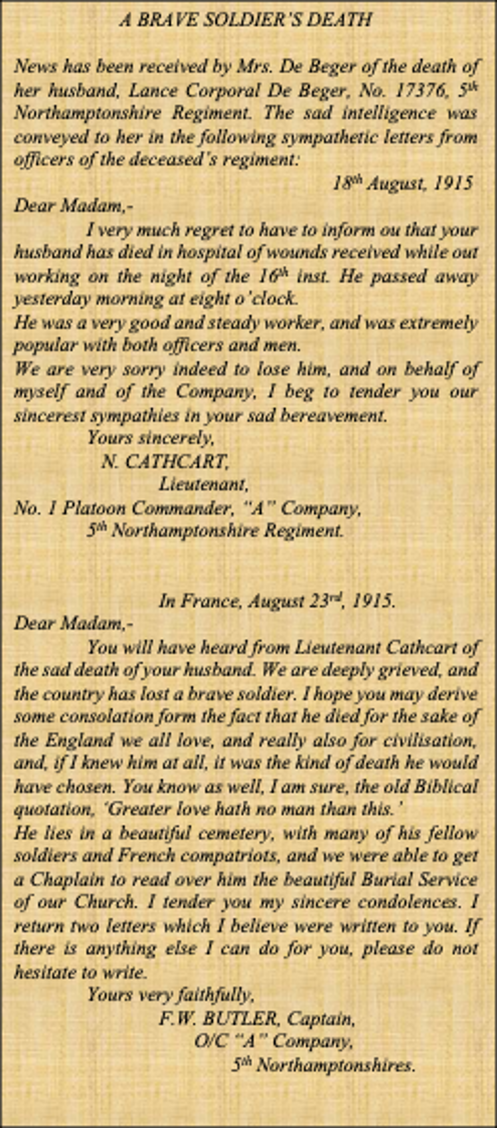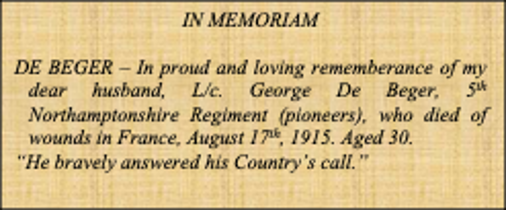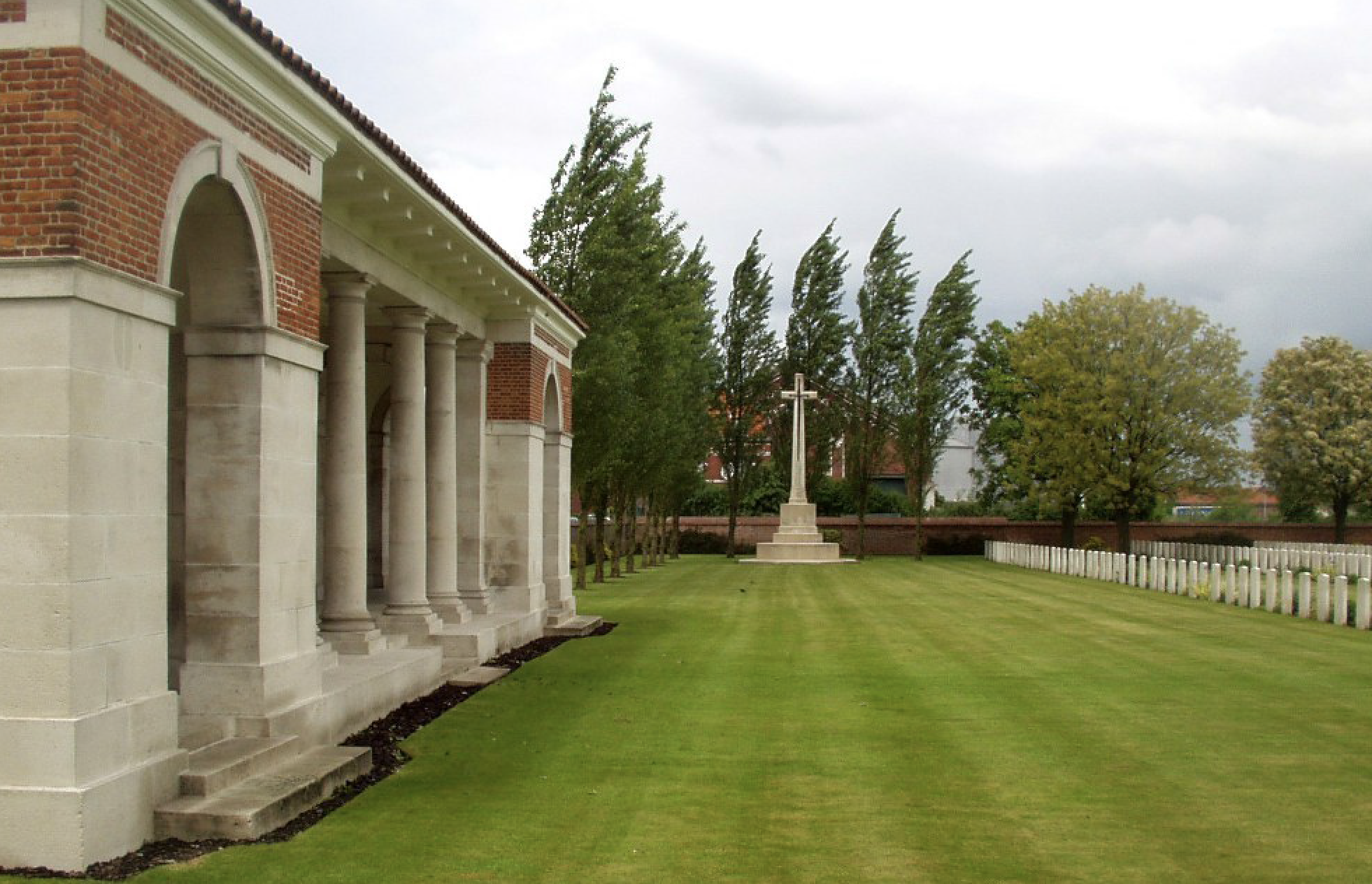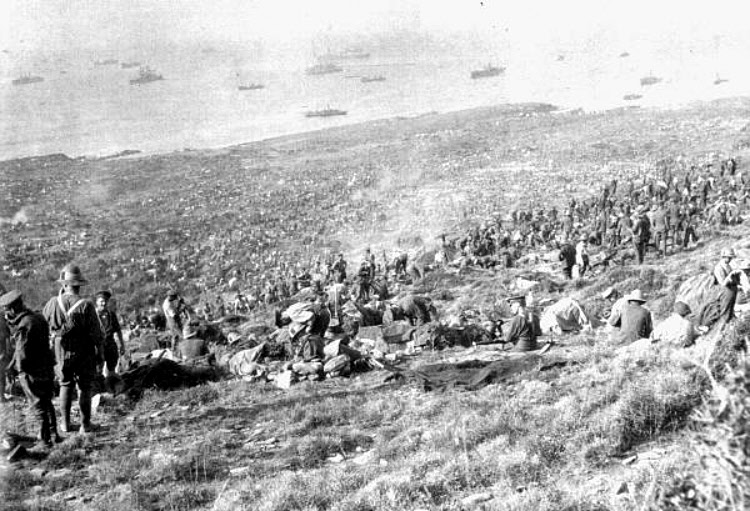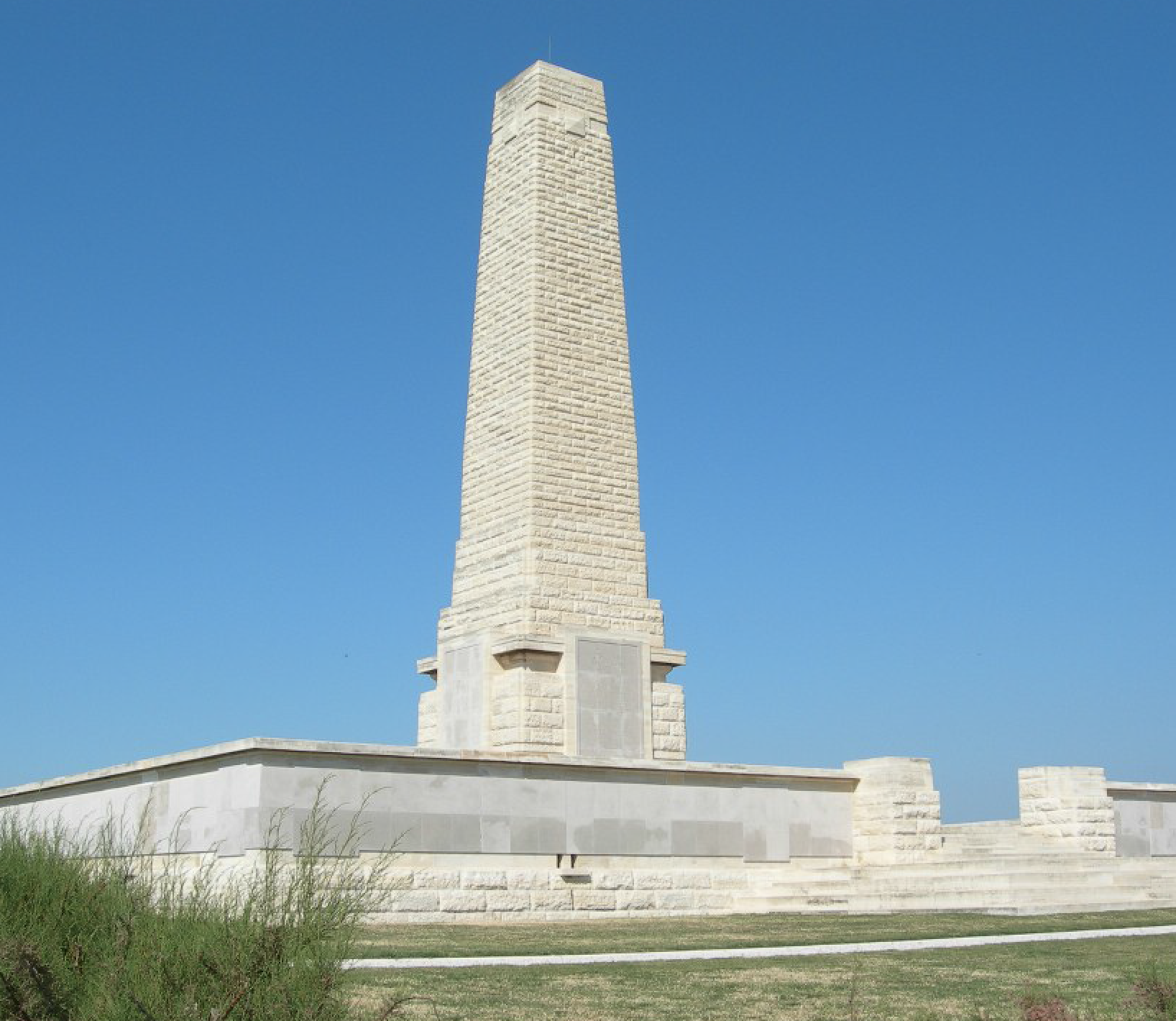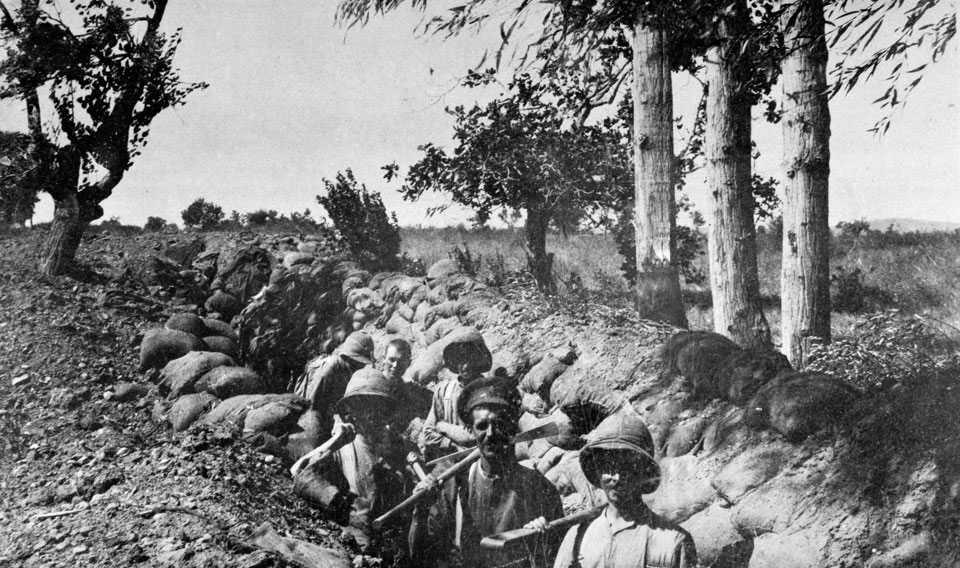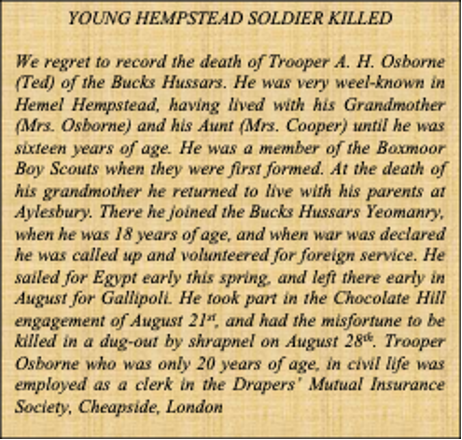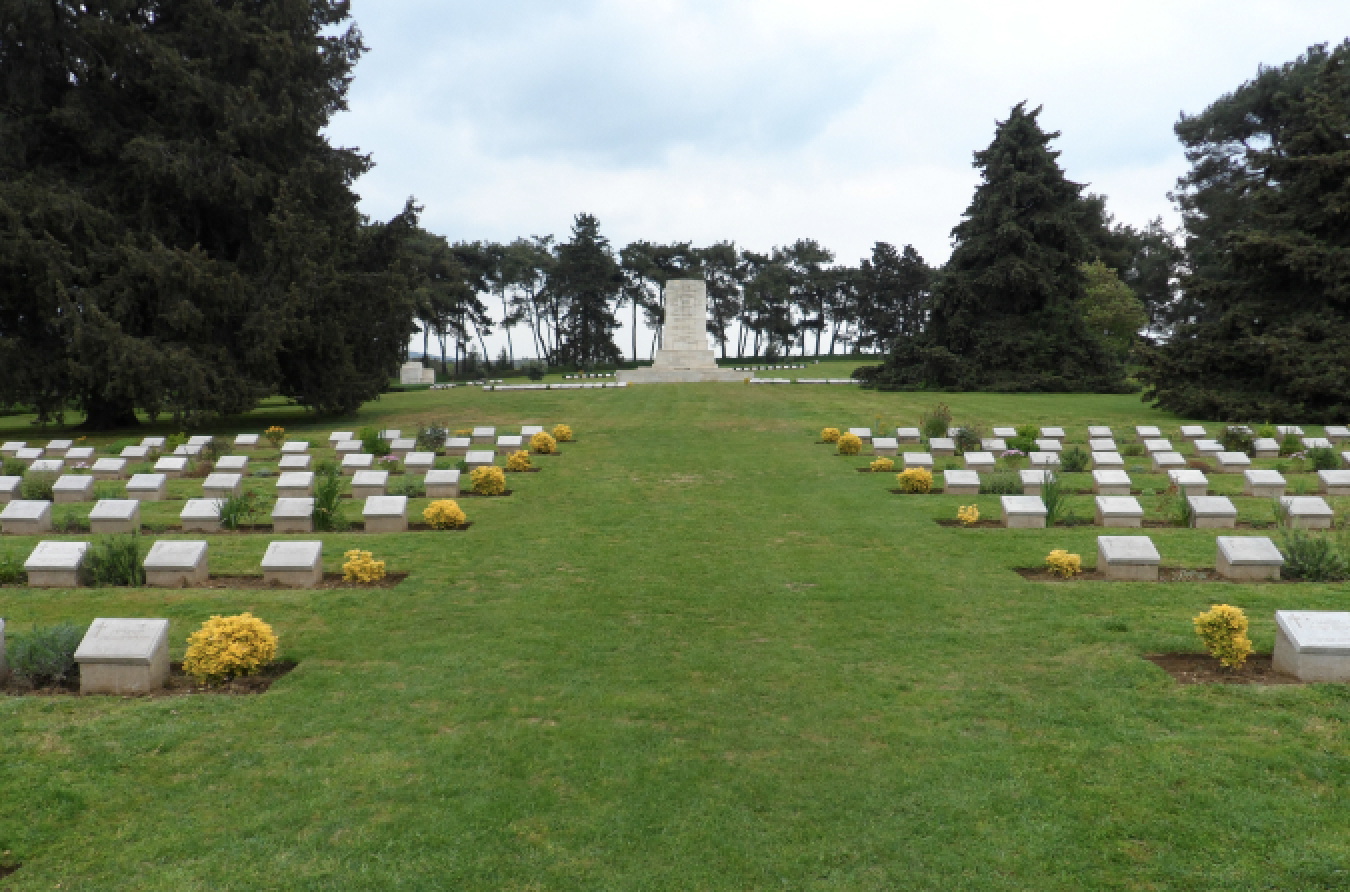Fallen in August 1915:
George DeBeger
Sydney John Chandler
Arthur Hamilton Osborne
GEORGE De BEGER
17376 Lance Corporal
5th Bn., Northamptonshire Regiment
Died of Wounds Tuesday, 17th August 1915
Remembered with Honour, Cite Bonjean Military Cemetery, Armentieres, Nord, France, Plot IX B 24
George Montague
Pearce was born on the Thursday 13th August 1885 in Paddington,
Middlesex to single mother Alice Mary Pearce. Shortly after his birth, Alice
met and married George William De Beger in 1888 at Chelsea and young George
adopted his step-father’s surname. Just two years later the first of George’s
five half-siblings, Mabel Elizabeth was born. She was followed by: Florence
Eugenie, Albert Leslie, Frederick Gordon and finally Alice Victoria.
George started school in 1890 firstly at St Clement’s National School, before moving to Oxford Gardens School on 24th August 1891, just two weeks after his sixth birthday. He left the school shortly afterwards when his step-father George, a Plumber by trade, moved the family sometime before 1894 to Bushey in Hertfordshire where the two youngest children were born.
By 1901 the family were living at 77 Villiers Road in Bushey and young George aged fifteen was working as a Mason’s Labourer. It was whilst working in the Watford area that he met his first wife Mabel Spires and they were married in the winter of 1907. George and Mabel moved to Walthamstow and had two daughters together, Mabel born in 1908 followed by Gladys in 1910. By this time George had changed jobs and was now working as a plumber, his step-father’s trade.
The young family were living back in Watford in 1911 at 29 High Street, Bushey Fields, the home of Albert and Elizabeth Spires, Mabel’s parents. It was here in the spring of 1913 that George and Mabel had their third daughter, Alice but tragedy followed this happy event. Just a year later on Saturday, 9th May 1914 Mabel suddenly died at home of a perforated ulcer at the age of 27 leaving George to bring up the three girls. They family was living at 75 School Lane in Bushey.
With the support of his in-laws, who took care of the children, George was able to continue working and this brought him to Leverstock Green. It was here that he met a local girl Minnie Woodwards who would become his second wife by the end of the year.
On the outbreak of war George enlisted at Watford in August and joined the Norfolk Regiment. He was posted to the 9th Battalion and sent to Shorncliffe Camp at Cheriton near Folkestone to undergo his basic training and soon afterwards was promoted Lance Corporal. It was common in the early days of the war for new soldiers with abilities to attain this rank so that units had sufficient junior NCOs to deal with the discipline and organisation of the huge numbers of new recruits to Kitchener’s Army.
George remained at Shorncliffe until early December 1914 when he returned to Leverstock Green and Minnie. They were married on Christmas Eve at Holy Trinity Church in Leverstock Green with George’s brother Albert acting as a witness to the happy event. Sadly, George’s brother Albert was killed in action at the Battle of Loos on 26th September 1915. His brother-in-law and one of Minnie’s older brothers, Harry Woodwards, was also killed in the conflict. His story appears later in this book.
George’s daughters moved from Bushey Fields to live with their father and new step-mother in Leverstock Green and were baptised together in Holy Trinity Church on the 21st March 1915.
On his return to his regiment, George transferred to the 5th (Service) Battalion Northamptonshire Regiment, one of the newly formed ‘Pioneer’ units. The vast demand for labour for engineering and construction work on the Western Front led to the formation of Pioneer Battalions following an Army Order in December 1914. They were made up of experienced labourers and skilled men who were also trained and capable of fighting and were attached to each infantry Division. George as a time served Plumber was an ideal man for the Pioneers.
He joined the 5th (Service) Battalion (Pioneers) at Hythe in Kent in January 1915 and the unit was attached to the 12th Division. In February the Battalion moved to Aldershot to finalise training and on May 30th it mobilised for war. A day later George disembarked at Boulogne in France and by the 6th June he had moved with his comrades to the Meteren-Steenwerk area in France close to the Belgian border.
For the rest of June and July the Battalion carried out a range of works south of Ypres and around Ploegsteert Wood before moving to billets at Papot Farm in Nieppe just outside Armentieres in early August. Casualties occurred on an almost daily basis during this time due mainly to the disruptive German shelling and this pattern continued into August. By 15th August plans had been made for the construction of a Light Tramway and the work began on the following day.
The Regiment’s War Diaries record that on Tuesday, 17th August 1915 "One man died of wounds". George De Beger was that man and he had been wounded by German shellfire earlier on that day. George had been in France for just eleven weeks when he was killed.
His death
was reported in the Hemel Gazette in the October following, after his wife
Minnie had received confirmation, along with two letters from his Company Lieutenant
and Captain. Both letters attest to George’s popularity amongst his comrades
and his bravery as a soldier. (see extract)
Each year for the duration of the War and on the anniversary of his death, Minnie placed an ‘In Memoriam’ notice in the Hemel Gazette proudly commemorating George. (see extract)
He is also commemorated on the Leverstock Greeen War Memorial and his parents remembered him on a memorial at Bushey and Oxhey Methodist Church.
Lce-Cprl. De Beger c 1914 (Courtesy: The Hertfordshire, Hemel Hempstead Gazette and West Herts Advertiser)
Extract from The Hertfordshire, Hemel Hempstead Gazette and West Herts Advertiser 16th Oct. 1915
Extract from The Hertfordshire, Hemel Hempstead and West Herts Gazette 18th Aug. 1917
Cite Bonjean Military Cemetery, Armentieres, Nord, France (CWGC)
In the 1919 Easter service at Holy Trinity Church George was remembered along with the other men from Leverstock Green who fell in the Great War.
George is Remembered with Honour at Cite Bonjean Military Cemetery, Armentieres, Nord, France where he is interred in Plot IX B 24. The inscription on his headstone, requested by Minnie, reads simply: “REST IN PEACE”
George was 30 years old when he died. He was eligible for the 1914-14 Star, the British War Medal and the Allied Victory Medal.
SYDNEY JOHN CHANDLER
6469 Corporal
8th Bn., Northumberland Fusiliers
Killed in Action Thursday, 19th August 1915
Remembered with Honour, Helles Memorial, Turkey, Panel 33
Sydney John Chandler was born in Trowbridge, Wiltshire on Thursday, 2nd June 1892 and baptised in Holy Trinity Church in the town on Sunday, 14th August in the same year. He was the second child and first son born to George Chandler and Jane Clingan. Sydney had two siblings, an older sister Dorothy Ada and a younger brother Victor George Clingan. Victor also saw action in the Great War as a sailor in the Royal Navy where he served from 1913 until 1926.
Sydney’s
father George was a Police Constable with Wiltshire Constabulary and it was this
service that would eventually bring the family to Hemel Hempstead. In 1901 when
Sydney was nine years old, the family were living at the Old Police House in
the small village of Kington St Michael just north of Chippenham in Wiltshire.
Both Sydney and his older sister Dorothy had started at Kington St Michael Church of England school on the 20th October 1898 shortly after coming to the village. They both left on the 5th May 1902 when their father was transferred to the Hertfordshire Constabulary and the family moved to Hemel Hempstead. However, misfortune followed in 1909 when Sydney’s father George was forced to retire from the Police due to illness which resulted in his paralysis.
By 1911, nineteen-year-old Sydney was working as a Domestic Gardener at Westbury Manor Gardens, Brackley in Buckinghamshire. This was the home of Sir Samuel Scott 6th Baronet and a retired soldier, who for twenty years was the Conservative MP for Marylebone West and the Assistant Private Secretary to the Earl of Derby, Secretary of War in 1916. George was one of five full time gardeners working at the Manor, but it appears that he moved north to Ashington, Northumberland at sometime before the outbreak of war.
His father George died in 1913 aged fifty, the first tragedy that befell the family. This was followed in five short years by Sydney’s death in 1915 and the deaths of his mother Jane and sister Dorothy as a result of ‘Spanish Flu’ in December 1918. It is estimated that as many as 100 million people succumbed to the epidemic (5% of the World’s population) whilst approximately 16 million people died in the Great War. Victor Chandler was the only family member left alive after 1918.
On the
outbreak of war Sydney joined the Northumberland Fusiliers, enlisting with the 8th (Service) Battalion in Sheffield, Yorkshire. The 8th Battalion had
been raised in Newcastle in August 1914 as part of Kitchener’s New Army and
Sydney joined his comrades at Belton Park Grantham for initial training. In
April 1915 he moved with the unit to join the new 11th (Northern) Division
at Witley north of Derby for final training.
Orders to mobilise arrived on 30th June 1915 and two days later Sydney sailed with the Battalion, as part of the 34th Infantry Brigade, from Liverpool aboard the SS Aquitania bound for Murdos on the Gallipoli peninsula. During the voyage the ship was attacked by enemy submarines but fortunately the torpedoes missed their target and the Battalion arrived at Murdos on the 10th July.
By early August the Battalion had moved to Kephalos Camp on Imbros just off the Turkish coast before taking part in the landing at Suvla Bay on the 6th August. This was the first action that Sydney and his comrades experienced. Suvla Bay was an amphibious landing made on the Aegean coast of the Gallipoli peninsula and part of the August Offensive, the final British attempt to break the deadlock of the Battle of Gallipoli.
Despite
facing only light opposition, the landing at Suvla was mismanaged from the
outset and quickly reached the same stalemate conditions that prevailed on the
Anzac and Helles fronts. On the 15th August, after a week of
indecision and inactivity, the British commander at Suvla, Lieutenant-General
Sir Frederick Stopford was dismissed. His performance in command is often
considered one of the most incompetent feats of generalship of the First World
War.
By the 19th August the 8th Northumberlands were ordered to attack an entrenched
Turkish position. Despite advancing some 700 yards and almost reaching the
enemy trenches, it failed to capture the position owing to heavy machine gun,
rifle and shrapnel fire. The Battalion retired having lost its 2nd C.O., eight officers wounded or missing and "other
ranks: 23 killed, 141 wounded, 88 missing and 2 wounded missing"
Sydney was one of the twenty-four men killed on Thursday, 19th August 1915.
He is Remembered with Honour on the Helles Memorial, Turkey on Panel 33.
Sydney was 23 years old when he died.
He was eligible for the 1914-15 Star, the British War Medal and the Allied Victory Medal.
The Old Police House, Kington St Michael, Wiltshire (Courtesy: Traquair Photography 25th June. 2017)
Northumberland Fusiliers Cap Badge World War 1
Suvla Bay Landing August 1915 (Courtesy:“Picture Gallery.” Daily Mail [London, England] 1 Dec. 1915 (WSRO RSR Mss 4/58))
Helles Memorial, Turkey (Courtesy: CWGC)
ARTHUR HAMILTON OSBORNE
880 Private
Royal Buckinghamshire Hussars
Killed in Action Saturday, 28th August 1915
Remembered with Honour, Green Hill Cemetery, Turkey, Plot II F 26
Arthur Hamilton Osborne was born on Tuesday, 6th November 1894 in Stoke Newington, London and baptised just over two weeks later on Sunday, 25th November. He was the first of two sons born to Arthur Edward Osborne and Alice Williams and he was known fondly as Ted. His younger brother Reginald Thomas was born three years later in 1897, and he too served during the war with the Royal Engineers and was demobbed in 1919.
When Ted
was born, the family lived at 17 Woodlea Road, Stoke Newington and his father
Arthur worked as a Sorting Clerk and Telegraphist for the General Post Office.
Arthur was continuing a long tradition of postal workers in the Osborne family.
Ted’s Grandfather Thomas had been a Grocer and the Postmaster for Hemel
Hempstead, with a shop in Alexandra Road and then the High Street in Hemel
Hempstead for over thirty years. No fewer than five of Ted’s Aunts and Uncles
worked in the postal business.
The family had moved to Aylesbury, Buckinghamshire by 1897 where Ted’s brother Reginald was born. In 1901 however, Ted was living with his Grandmother Eliza at Crescent Road, Hemel Hempstead whilst his parents and brother where resident in Aylesbury where his father worked. Indeed, Ted remained with his Grandmother and his Aunt Minnie until he was sixteen, only returning to live with his parents when his Grandmother died in 1910. During his time in Hemel Hempstead he was an active and popular member of the Boxmoor Boy Scouts and was one of the original members. He was well known throughout the town.
By 1911 young Ted was working but surprisingly, not for the Post Office; instead was apprenticed to the Drapers trade. In 1912 when he was eighteen, he enlisted in the Territorial Force (TF) with the Royal Buckinghamshire Yeomanry joining ‘B’ Squadron at Aylesbury. He may have been motivated by his Father’s TF service with the Signal Company Royal Engineers which he had joined in 1908 aged thirty-five. Indeed, he served with Division H.Q. throughout the War attaining the rank of Serjeant and finally being demobbed in 1919.
On the outbreak of war Ted, like many in the TF, was called up as a reservist and volunteered for overseas service with the Royal Bucks and was appointed to the 1/1st Battalion. Initially, the Battalion was concentrated in Berkshire and on the 5th August, joined the 1st Mounted Division. On the 2nd September as part of the 2nd South Midland Mounted Brigade it was transferred to the 2nd Mounted Division and in mid-November it moved with the division to Norfolk on coastal defence duties.
Ted remained in Norfolk until the following spring when the Division was mobilised and sent to the Middle East. In April 1915, the 2nd Mounted Division moved to Egypt arriving at Alexandria between 19th and 21st April and was then posted to Cairo by the middle of May. The regiment was dismounted in August 1915 to take part in the Gallipoli Campaign and immediately sailed for Turkey.
It landed at "A" Beach, Suvla Bay on the 18th August before advancing to ‘Chocolate Hill’ two days later. Ted with his comrades then saw action in the attack on ‘Scimitar Hill’. This was the largest single-day attack ever mounted by the Allies at Gallipoli, involving three divisions. The purpose was to remove the immediate Ottoman threat from the exposed Suvla landing and to link with the ANZAC sectors to the south. Launched on the 21st August 1915, it proved to be a costly failure.
Around 5:00 p.m. the troops of the 2nd Mounted Division were ordered forward from their reserve position on Lala Baba and advanced, marching across the bed of a dry salt lake. The 5,000 men of the five brigades formed in columns by regiment and, marching in extended order, were easy targets for the shrapnel. Most of them halted in the cover of Green Hill west of Scimitar Hill, but Brigadier-General Lord Longford led his 2nd South Midland Mounted Brigade in a charge over Green Hill and up to the summit of Scimitar Hill. Lord Longford was cut off and killed and the yeomanry too were driven from the summit.
The attack
at Scimitar Hill was the last attempt by the British to advance at Suvla. The
front line remained between Green Hill and Scimitar Hill for the remainder of
the campaign until the evacuation in December 1915. In all the allies suffered
over 5000 casualties in the action.
Ted survived the attack, but he was unfortunately killed by shrapnel only a week later, on Saturday 25th August 1915, whilst in a dug-out near "Chocolate Hill.
His death was reported in the Hemel Gazette a month after he was killed. (see extract)
17 Woodlea Road, Stoke Newington where Ted was born in 1894 (Courtesy: Google Maps)
Soldiers dug in at Chocolate Hill, Gallipoli 1915 (Courtesy: National Army Museum)
Extract from The Hertfordshire, Hemel Hempstead Gazette and West Herts Advertiser 25th Sep. 1915
Green Hill Cemetery, Turkey (Courtesy: CWGC)
Ted is Remembered with Honour in Green Hill Cemetery, Turkey, where he is interred in Plot II F 26
He was 20 years old when he died.
Ted was eligible for the 1914-15 Star, the British War Medal and the Allied Victory Medal.
